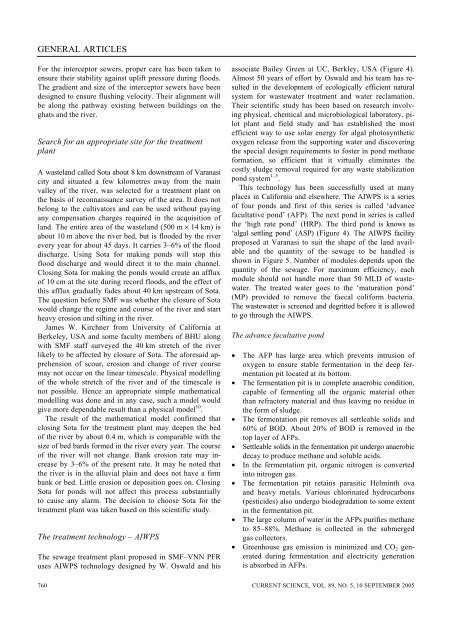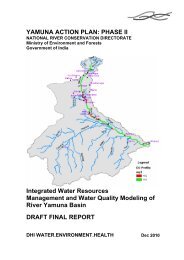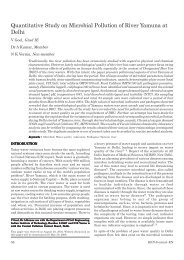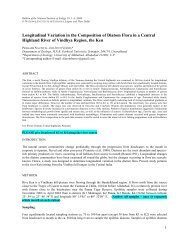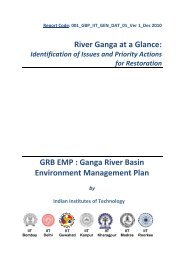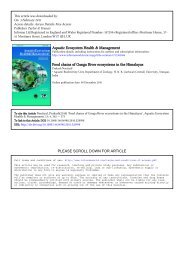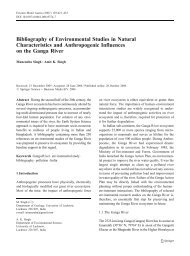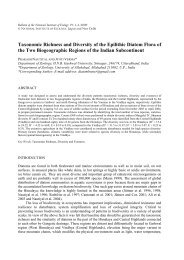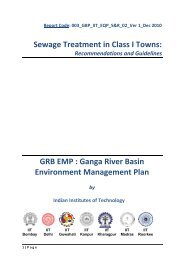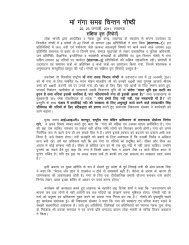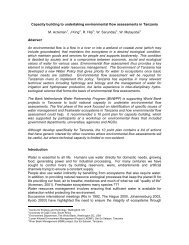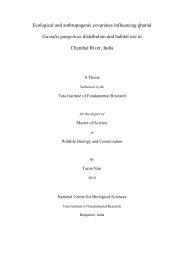The Ganga at Varanasi and a travail to stop her abuse - GANGAPEDIA
The Ganga at Varanasi and a travail to stop her abuse - GANGAPEDIA
The Ganga at Varanasi and a travail to stop her abuse - GANGAPEDIA
You also want an ePaper? Increase the reach of your titles
YUMPU automatically turns print PDFs into web optimized ePapers that Google loves.
GENERAL ARTICLES<br />
For the intercep<strong>to</strong>r sewers, proper care has been taken <strong>to</strong><br />
ensure their stability against uplift pressure during floods.<br />
<strong>The</strong> gradient <strong>and</strong> size of the intercep<strong>to</strong>r sewers have been<br />
designed <strong>to</strong> ensure flushing velocity. <strong>The</strong>ir alignment will<br />
be along the p<strong>at</strong>hway existing between buildings on the<br />
gh<strong>at</strong>s <strong>and</strong> the river.<br />
Search for an appropri<strong>at</strong>e site for the tre<strong>at</strong>ment<br />
plant<br />
A wastel<strong>and</strong> called Sota about 8 km downstream of <strong>Varanasi</strong><br />
city <strong>and</strong> situ<strong>at</strong>ed a few kilometres away from the main<br />
valley of the river, was selected for a tre<strong>at</strong>ment plant on<br />
the basis of reconnaissance survey of the area. It does not<br />
belong <strong>to</strong> the cultiv<strong>at</strong>ors <strong>and</strong> can be used without paying<br />
any compens<strong>at</strong>ion charges required in the acquisition of<br />
l<strong>and</strong>. <strong>The</strong> entire area of the wastel<strong>and</strong> (500 m × 14 km) is<br />
about 10 m above the river bed, but is flooded by the river<br />
every year for about 45 days. It carries 3–6% of the flood<br />
discharge. Using Sota for making ponds will s<strong>to</strong>p this<br />
flood discharge <strong>and</strong> would direct it <strong>to</strong> the main channel.<br />
Closing Sota for making the ponds would cre<strong>at</strong>e an afflux<br />
of 10 cm <strong>at</strong> the site during record floods, <strong>and</strong> the effect of<br />
this afflux gradually fades about 40 km upstream of Sota.<br />
<strong>The</strong> question before SMF was whet<strong>her</strong> the closure of Sota<br />
would change the regime <strong>and</strong> course of the river <strong>and</strong> start<br />
heavy erosion <strong>and</strong> silting in the river.<br />
James W. Kirchner from University of California <strong>at</strong><br />
Berkeley, USA <strong>and</strong> some faculty members of BHU along<br />
with SMF staff surveyed the 40 km stretch of the river<br />
likely <strong>to</strong> be affected by closure of Sota. <strong>The</strong> aforesaid apprehension<br />
of scour, erosion <strong>and</strong> change of river course<br />
may not occur on the linear timescale. Physical modelling<br />
of the whole stretch of the river <strong>and</strong> of the timescale is<br />
not possible. Hence an appropri<strong>at</strong>e simple m<strong>at</strong>hem<strong>at</strong>ical<br />
modelling was done <strong>and</strong> in any case, such a model would<br />
give more dependable result than a physical model 10 .<br />
<strong>The</strong> result of the m<strong>at</strong>hem<strong>at</strong>ical model confirmed th<strong>at</strong><br />
closing Sota for the tre<strong>at</strong>ment plant may deepen the bed<br />
of the river by about 0.4 m, which is comparable with the<br />
size of bed bards formed in the river every year. <strong>The</strong> course<br />
of the river will not change. Bank erosion r<strong>at</strong>e may increase<br />
by 3–6% of the present r<strong>at</strong>e. It may be noted th<strong>at</strong><br />
the river is in the alluvial plain <strong>and</strong> does not have a firm<br />
bank or bed. Little erosion or deposition goes on. Closing<br />
Sota for ponds will not affect this process substantially<br />
<strong>to</strong> cause any alarm. <strong>The</strong> decision <strong>to</strong> choose Sota for the<br />
tre<strong>at</strong>ment plant was taken based on this scientific study.<br />
<strong>The</strong> tre<strong>at</strong>ment technology – AIWPS<br />
<strong>The</strong> sewage tre<strong>at</strong>ment plant proposed in SMF–VNN PFR<br />
uses AIWPS technology designed by W. Oswald <strong>and</strong> his<br />
760<br />
associ<strong>at</strong>e Bailey Green <strong>at</strong> UC, Berkley, USA (Figure 4).<br />
Almost 50 years of effort by Oswald <strong>and</strong> his team has resulted<br />
in the development of ecologically efficient n<strong>at</strong>ural<br />
system for wastew<strong>at</strong>er tre<strong>at</strong>ment <strong>and</strong> w<strong>at</strong>er reclam<strong>at</strong>ion.<br />
<strong>The</strong>ir scientific study has been based on research involving<br />
physical, chemical <strong>and</strong> microbiological labor<strong>at</strong>ory, pilot<br />
plant <strong>and</strong> field study <strong>and</strong> has established the most<br />
efficient way <strong>to</strong> use solar energy for algal pho<strong>to</strong>synthetic<br />
oxygen release from the supporting w<strong>at</strong>er <strong>and</strong> discovering<br />
the special design requirements <strong>to</strong> foster in pond methane<br />
form<strong>at</strong>ion, so efficient th<strong>at</strong> it virtually elimin<strong>at</strong>es the<br />
costly sludge removal required for any waste stabiliz<strong>at</strong>ion<br />
pond system 1–5 .<br />
This technology has been successfully used <strong>at</strong> many<br />
places in California <strong>and</strong> elsew<strong>her</strong>e. <strong>The</strong> AIWPS is a series<br />
of four ponds <strong>and</strong> first of this series is called ‘advance<br />
facult<strong>at</strong>ive pond’ (AFP). <strong>The</strong> next pond in series is called<br />
the ‘high r<strong>at</strong>e pond’ (HRP). <strong>The</strong> third pond is knows as<br />
‘algal settling pond’ (ASP) (Figure 4). <strong>The</strong> AIWPS facility<br />
proposed <strong>at</strong> <strong>Varanasi</strong> <strong>to</strong> suit the shape of the l<strong>and</strong> available<br />
<strong>and</strong> the quantity of the sewage <strong>to</strong> be h<strong>and</strong>led is<br />
shown in Figure 5. Number of modules depends upon the<br />
quantity of the sewage. For maximum efficiency, each<br />
module should not h<strong>and</strong>le more than 50 MLD of wastew<strong>at</strong>er.<br />
<strong>The</strong> tre<strong>at</strong>ed w<strong>at</strong>er goes <strong>to</strong> the ‘m<strong>at</strong>ur<strong>at</strong>ion pond’<br />
(MP) provided <strong>to</strong> remove the faecal coliform bacteria.<br />
<strong>The</strong> wastew<strong>at</strong>er is screened <strong>and</strong> degritted before it is allowed<br />
<strong>to</strong> go through the AIWPS.<br />
<strong>The</strong> advance facult<strong>at</strong>ive pond<br />
• <strong>The</strong> AFP has large area which prevents intrusion of<br />
oxygen <strong>to</strong> ensure stable ferment<strong>at</strong>ion in the deep ferment<strong>at</strong>ion<br />
pit loc<strong>at</strong>ed <strong>at</strong> its bot<strong>to</strong>m.<br />
• <strong>The</strong> ferment<strong>at</strong>ion pit is in complete anaerobic condition,<br />
capable of fermenting all the organic m<strong>at</strong>erial ot<strong>her</strong><br />
than refrac<strong>to</strong>ry m<strong>at</strong>erial <strong>and</strong> thus leaving no residue in<br />
the form of sludge.<br />
• <strong>The</strong> ferment<strong>at</strong>ion pit removes all settleable solids <strong>and</strong><br />
60% of BOD. About 20% of BOD is removed in the<br />
<strong>to</strong>p layer of AFPs.<br />
• Settleable solids in the ferment<strong>at</strong>ion pit undergo anaerobic<br />
decay <strong>to</strong> produce methane <strong>and</strong> soluble acids.<br />
• In the ferment<strong>at</strong>ion pit, organic nitrogen is converted<br />
in<strong>to</strong> nitrogen gas.<br />
• <strong>The</strong> ferment<strong>at</strong>ion pit retains parasitic Helminth ova<br />
<strong>and</strong> heavy metals. Various chlorin<strong>at</strong>ed hydrocarbons<br />
(pesticides) also undergo biodegrad<strong>at</strong>ion <strong>to</strong> some extent<br />
in the ferment<strong>at</strong>ion pit.<br />
• <strong>The</strong> large column of w<strong>at</strong>er in the AFPs purifies methane<br />
<strong>to</strong> 85–88%. Methane is collected in the submerged<br />
gas collec<strong>to</strong>rs.<br />
• Greenhouse gas emission is minimized <strong>and</strong> CO2 gener<strong>at</strong>ed<br />
during ferment<strong>at</strong>ion <strong>and</strong> electricity gener<strong>at</strong>ion<br />
is absorbed in AFPs.<br />
CURRENT SCIENCE, VOL. 89, NO. 5, 10 SEPTEMBER 2005


